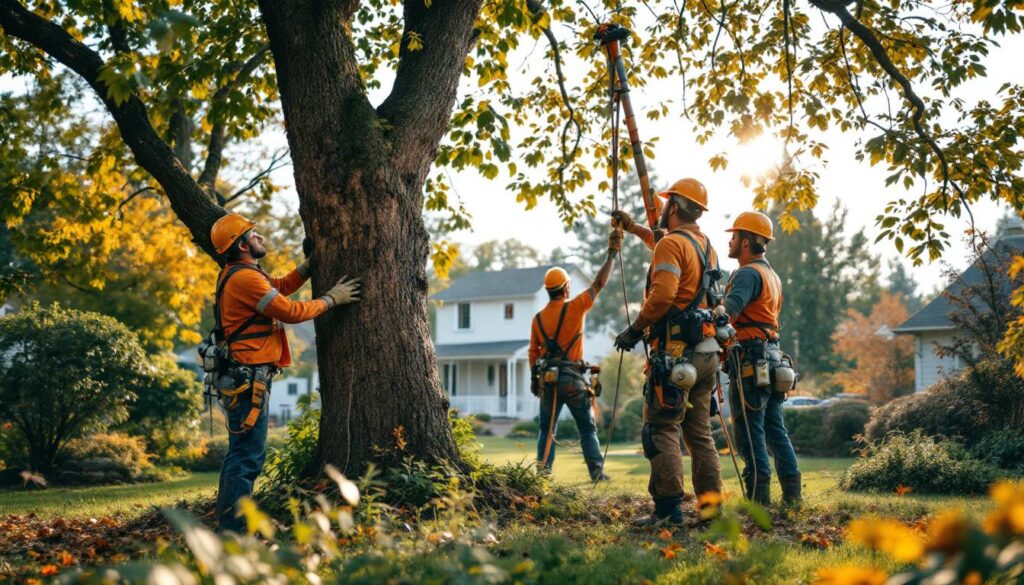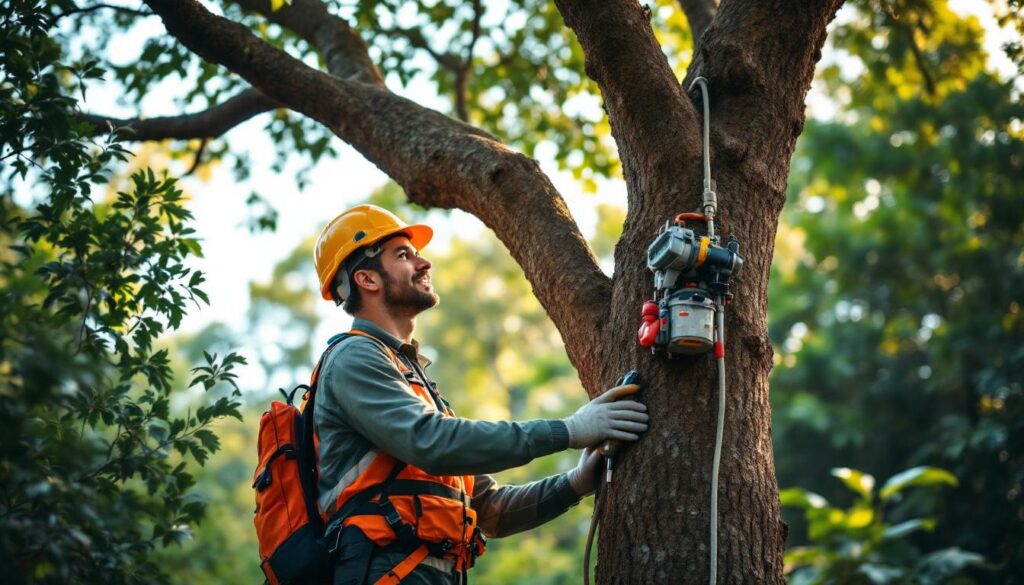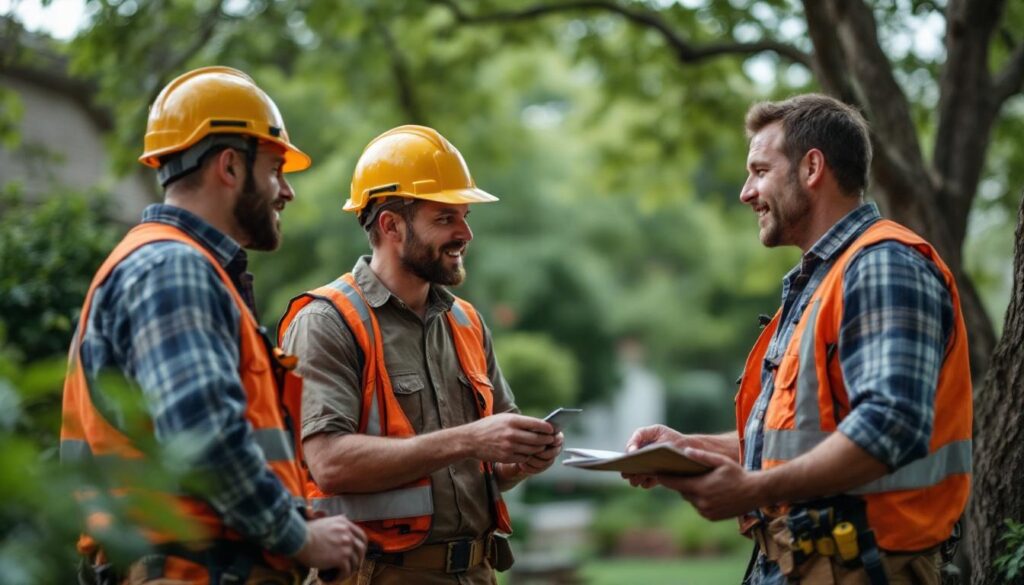Why Should You Hire a Certified Arborist in Carlingford for Large Tree Pruning and Maintenance?
Large trees require specialized knowledge that only certified professionals have. An Arborist Carlingford has the technical expertise to assess structural integrity, identify diseases early on, and carry out precise pruning that protects both your property and the health of the tree.
The Risks of DIY Large Tree Pruning
Trying to prune large trees without proper training can be extremely dangerous. Here are some risks involved:
- Falls from height
- Electrocution near power lines
- Falling branches
These dangers are immediate threats to anyone who is not trained. Professional arborist undergo strict safety certification and use industry-standard equipment to eliminate these hazards.
The Importance of Tree Maintenance Planning
Tree maintenance planning involves more than just one pruning session. Certified arborists create detailed care strategies that are specific to each tree’s species, age, and condition. This ensures that your trees receive the appropriate care they need to thrive.
The difference between amateur tree work and professional care can often determine whether your large trees flourish for many years or become potential liabilities that require early removal.
What Are the Key Safety Considerations When Planning Pruning for Large Trees?
Large tree pruning requires specialized technical skills due to significant height, weight, and structural complexity. Working at elevated heights with heavy equipment near power lines creates serious hazards that untrained individuals cannot safely navigate.
Tree pruning safety requires certified arborists who complete rigorous training in risk management protocols. These professionals understand load distribution, proper cutting angles, and equipment operation standards that prevent accidents during complex procedures.
The most critical hazards include:
- Falls from height – Working 10-30 metres above ground without proper harness systems and anchor points
- Electrocution – Contact with overhead power lines during branch removal or equipment operation
- Falling debris – Large limbs weighing hundreds of kilograms dropping unexpectedly
- Property damage – Uncontrolled branch falls crushing roofs, vehicles, or fencing
- Equipment injuries – Chainsaw kickback, rope failures, or rigging malfunctions
Certified arborists implement risk management for large trees through systematic approaches. They establish exclusion zones around work areas, use aerial lifts or climbing systems with redundant safety attachments, and employ rigging techniques that control branch descent. Pre-work site assessments identify power line proximity, ground obstacles, and escape routes. Teams maintain constant communication using hand signals and radios whilst one member monitors operations from ground level, ready to respond to emergencies.
How Do Arborists Assess Large Trees Before Maintenance?
Professional arborists begin with a systematic tree health assessment that examines every aspect of the tree from canopy to roots. This comprehensive evaluation forms the foundation for all subsequent maintenance decisions.
The inspection process targets specific health indicators:
- Canopy condition – checking leaf density, colour variations, and premature leaf drop
- Bark integrity – identifying cracks, splits, or unusual growths
- Branch structure – spotting dead limbs, crossing branches, or weak attachments
- Root zone – examining soil conditions and visible root damage
Disease detection trees requires trained eyes to spot early warning signs. Arborists look for fungal growth, discoloured patches, oozing sap, or pest infestations that compromise tree vitality. Decay pockets within the trunk or major branches receive particular attention, as internal rot often remains hidden until advanced stages.
Structural integrity evaluation determines whether the tree poses immediate risks. Arborists measure lean angles, assess co-dominant stems that may split, and identify cavities that weaken load-bearing capacity. Growth patterns reveal historical stress, environmental pressures, and previous damage that affects current stability.
Each assessment generates a tailored care plan addressing identified issues. A tree showing minor disease might need targeted treatment and monitoring, whilst structural weaknesses could require strategic pruning to redistribute weight. This individualised approach ensures maintenance efforts address actual needs rather than applying generic solutions.
What Are the Most Effective Pruning Techniques for Large Trees?
Professional arborists employ specific pruning methods for large trees that enhance structural integrity whilst reducing hazards. Strategic pruning stimulates healthy growth patterns, improves air circulation through the canopy, and minimises the risk of branch failure during severe weather events.
Crown Thinning
Crown thinning selectively removes interior branches throughout the canopy to increase light penetration and reduce wind resistance. This technique maintains the tree’s natural shape whilst allowing sunlight to reach lower branches and surrounding vegetation. Arborists carefully select which branches to remove, ensuring even distribution and avoiding over-thinning that could stress the tree.
Shaping
Shaping addresses both aesthetic concerns and safety requirements, particularly when branches encroach on structures or power lines. Certified arborists in Carlingford understand clearance regulations and prune accordingly to prevent electrical hazards whilst preserving the tree’s health and appearance.
Deadwood Removal
Deadwood removal eliminates deceased or dying branches that attract wood-boring insects and fungal pathogens. These compromised limbs pose significant falling risks during storms and create entry points for disease. Prompt removal protects both the tree and surrounding property.
Corrective Pruning
Corrective pruning rectifies structural weaknesses such as co-dominant stems, crossing branches, or poorly attached limbs. This preventative approach strengthens the tree’s framework, reducing the likelihood of catastrophic failure as the tree matures. For more insight into this technique, you can refer to this detailed article on corrective pruning.
When planning Arborist Carlingford how to plan pruning and maintenance for large trees, combining these techniques creates comprehensive care that extends tree longevity. Moreover, adhering to recommended tree care practices ensures optimal health and safety for both trees and their surroundings.

Which Tools and Methods Do Arborists Use to Maintain Large Trees Safely?
Professional arborists rely on specialized arborist tools and tree pruning equipment designed specifically for large-scale operations. Certified professionals use hydraulic lifts, rigging systems, and precision cutting tools that allow safe access to canopy heights whilst maintaining control throughout the pruning process.
Equipment Used by Arborists
Modern equipment enables arborists to execute precise cuts that promote natural healing responses in trees. The following tools are commonly used:
- Hand saws
- Pole pruners
- Pneumatic tools
These tools create clean wounds that seal quickly, reducing infection risks. Rigging techniques distribute weight safely during branch removal, preventing bark stripping or structural damage to the trunk.
Stump Grinding Services in Carlingford
Stump grinding Carlingford services address the aftermath of tree removal by mechanically reducing stumps to wood chips below ground level. This process eliminates trip hazards, prevents pest colonization, and stops unwanted regrowth from root systems. Specialized grinding machines can handle stumps of any size whilst minimizing disturbance to surrounding landscapes.
Safety Measures for Arborists
Safety harnesses, helmets, and protective gear form essential components of professional tree maintenance. Arborists combine this protective equipment with methodical planning to manage risks associated with:
- Overhead branch weight and trajectory during cutting
- Proximity to power lines or structures
- Ground crew coordination during material lowering
- Weather conditions affecting grip and visibility
Each tool selection and technique application reflects years of training in biomechanics and tree physiology, ensuring maintenance work strengthens rather than compromises tree integrity.
See Also : Arborist Gordon how canopy thinning improves light and tree health
How Is a Long-Term Maintenance Plan Developed for Large Trees?
A tree maintenance schedule changes reactive care into strategic preservation. Certified arborists design customised plans that extend tree lifespan through systematic monitoring rather than sporadic interventions.
Regular Inspections
Regular inspections trees require occur at specific intervals based on species, age, and environmental exposure. Most large trees benefit from bi-annual assessments—spring evaluations before active growth and autumn checks before dormancy. High-risk specimens near structures or power lines warrant quarterly reviews.
Seasonal Pruning Cycles
Seasonal pruning cycles align with natural growth patterns. Dormant-season pruning (late winter) minimises sap loss and stress, whilst summer pruning controls vigorous growth. Arborists schedule these interventions years in advance, creating predictable care rhythms that support optimal health.
Storm Damage Management
Storm damage management forms a critical component. Pre-storm assessments identify vulnerable branches and structural weaknesses requiring reinforcement. Post-storm protocols include emergency stabilisation, damage documentation, and recovery pruning to restore canopy balance.
Root Care
Root care extends beyond visible canopy work. Maintenance plans incorporate:
- Soil testing and amendment schedules
- Mulching protocols to retain moisture
- Root zone protection during nearby construction
- Mycorrhizal treatments to enhance nutrient uptake
Preventative Treatments
Preventative treatments target region-specific threats. Carlingford’s climate demands vigilance against fungal pathogens and pest pressures. Scheduled applications of organic treatments and biological controls maintain tree resilience without chemical dependence.
Why Is Environmental Responsibility Important in Tree Pruning and Maintenance?
Professional arborists in Carlingford prioritise eco-friendly tree care to protect local ecosystems during pruning and maintenance work. Every cut, treatment, and removal affects the surrounding environment, from soil microorganisms to wildlife habitats.
Minimising Ecosystem Disruption
Certified arborists plan operations to avoid nesting seasons, preserve beneficial insects, and protect understory plants. They assess each tree’s role in the broader landscape before recommending interventions, ensuring native species and established ecosystems remain intact.
Responsible Debris Disposal
Green waste from pruning activities never goes to landfill when handled by professional debris disposal arborists. Wood chips become mulch for gardens, larger branches transform into firewood, and organic material gets composted. This circular approach reduces environmental impact whilst providing valuable resources to the community.
Sustainable Treatment Methods
Modern sustainable practices trees rely on biological controls rather than harsh chemicals. Arborists apply organic fungicides, use pheromone traps for pest management, and promote natural predator populations. Soil treatments focus on mycorrhizal inoculants and organic amendments that strengthen tree immunity without contaminating groundwater.
When considering how to plan pruning and maintenance for large trees, environmental stewardship forms the foundation of every decision. These practices ensure your property’s trees contribute positively to Carlingford’s urban forest whilst maintaining their health and structural integrity for decades.
What Emergency Services Do Certified Arborists Offer in Carlingford?
Emergency tree services Carlingford teams operate around the clock to respond to urgent tree-related hazards. Certified arborists maintain 24/7 availability because tree emergencies rarely occur during convenient business hours—severe weather, sudden limb failure, or structural collapse can happen at any moment.
Storm Response
Storm response arborists specialise in managing dangerous situations created by extreme weather events. When high winds, heavy rain, or lightning damage trees, these professionals arrive equipped to assess risk levels immediately. They determine whether partially fallen trees pose immediate threats to buildings, vehicles, power lines, or pedestrian areas.
Hazardous Tree Removal
Hazardous tree removal becomes critical when trees lean precariously over structures or block essential access routes. Emergency arborists use specialised rigging systems and cutting techniques to dismantle unstable trees safely, even in confined spaces or challenging conditions. Their training allows them to work efficiently under pressure whilst maintaining strict safety protocols.
Preventing Secondary Damage
Prompt expert intervention prevents secondary damage that often exceeds the initial impact. A tree resting against a roof may seem stable but can shift unexpectedly, causing catastrophic structural failure. Professional assessment within hours of an incident identifies hidden risks like compromised root systems or internal splitting that aren’t visible to untrained observers.
Emergency Response Services
Emergency response capabilities include:
- Immediate site safety evaluation and hazard containment
- Strategic removal of fallen or hanging branches
- Complete tree dismantling when structural integrity is compromised
- Debris clearance to restore property access
- Temporary support systems for damaged but salvageable trees

How Can You Ensure Expert Care for Large Trees in Carlingford?
Hire certified arborist Carlingford professionals who understand the unique requirements of your property’s large trees. Expert care begins with a comprehensive consultation where qualified arborists evaluate your trees’ current condition and future needs.
Large tree care experts develop customised maintenance schedules that address seasonal pruning requirements, structural assessments, and preventative treatments. These tailored plans ensure your trees remain healthy, safe, and visually appealing throughout their lifespan.
Arborist Carlingford how to plan pruning and maintenance for large trees becomes straightforward when you partner with certified professionals who bring:
- Advanced training in modern pruning techniques
- Specialised equipment for safe, efficient work
- Knowledge of local tree species and environmental conditions
- 24/7 emergency response capabilities
Don’t wait for visible problems to develop. Contact certified local arborists today to schedule an assessment and establish a proactive maintenance plan. Professional guidance protects your investment in mature trees whilst safeguarding your property and loved ones from potential hazards.
